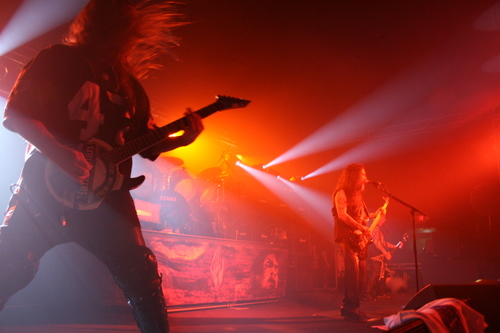How to Record Your Rock Band

There are few things more rewarding or more stressful than seeing your music gradually come together in the studio. It's the greatest feeling in the world being able to hand anyone a cd and tell them to "check out my band." The sense of accomplishment is very powerful. Recording is a key area where a rock band can really hone its chops and demonstrate its songs to best advantage.
But before the band can walk the red carpet and parade its platinum records, it must spend a good while in the studio. I should note here that a studio can be any place that the band feels best captures its vibe-it doesn't have to be The Record Plant or Sugarhill Studios. With all the advances being made in recording software, soundcards and peripheral devices, it's completely possible to realize professional results within the confines of your living room.
Where do we begin? Before we begin, one person in the band will typically become the designated recording engineer/producer. This person will usually be the most knowledgeable about recording, comparatively speaking, that is. This is the role that fell on me when I was in a band. Nevertheless, before we even begin to think about recording we must do the following:
- Instruct the drummer to replace all the drum heads, to tune them and to sufficiently lubricate all the moving parts of the kick drum pedal and the hi-hat. There's nothing more annoying than having a perfectly good drum take being ruined by a squeaky kick drum pedal.
- Instruct the bassist and the guitarist(s) to restring their instruments and to sufficiently break them in so that they stay in tune during the recording sessions. Also, have the guitarists replace the batteries on their pedals, and the tubes on their amps where necessary.
- Instruct the keyboardist/programmer to finalize his midi patches/sequences and ask how many tracks he will require for his associated gear-keyboards, samplers, drum machines.
- Discuss the choice of microphones with the vocalist, if possible. This is where experimentation is critical. The vocalist may use a Shure sm58 by habit but he might be surprised by the results of singing through an Oktava, for example. It's important to note here that most recording hobbyists will not have access to a Neumann U87 or other high-end professional tube mics; they'll typically employ Shure sm58s and 57s, Oktava, Audio Technica, and AKG microphones.
- Finally and most importantly, in our new capacity as recording engineers we instruct the band to methodically rehearse the songs that it intends to record. The band can be proactive here-it can record all its rehearsal sessions and discuss what needs more work after collectively listening to the performances.
After all these steps are followed the band will be ready to step into the studio and record its soon-to-be chart-topping songs(hopefully). What we do is have the drummer set up his kit in a sound-proof room (relatively speaking). We place foam and/or plush carpeting on all the walls so as to prevent sound waves from reflecting and bouncing all over the place-we want to avoid phase cancellation. Next we place an appropriate kick drum mic( AKG D112 or Rode NT1, NT2 etc.) inside the kick drum along with an oversized pillow. We then proceed to place two overhead mics (Left and Right) and we angle them downward so that they can capture the sound of the toms. The choice of overheads is as endless as the stars in the sky but you really can't go wrong using a pair of Rode NT1s or NT2s. They're that good. For the snare we can use our workhorse Shure sm57. With this setup the drumkit is pretty much covered although I'm sure the purists will always clamor for more mics.
Next we move on to record the bass guitar-a relatively straightforward affair, comparatively speaking. Most bass amps, thankfully, offer a plethora of options when it comes to recording the bass signal. Usually we'll have a direct out, a cabinet simulator and a pre and post eq output. This is all pretty cool because as recording engineers we always want options. The standard procedure for a lot of producers is to route the direct out from the bass amp into high end preamps such as an Avalon, Universal Audio and Focusrite. In my own experience I would place a full-range mic (Electro Voice RE 20) directly in front of the speaker cone, off-axis and about 2-3 inches back from the speaker. So I would have 3 microphones on the speaker. Why? I did this in order to achieve the ideal eq curve from the mics and not from the mixer or the various plug-ins. In this manner if I need a sharper attack I raise the gain on the mic directly in front of the speaker and if I need more bass I attenuate this same mic and increase the gain on the off-axis mic.
We set up to record the guitars in a similar fashion as we recorded the bass. This means that we look for pre-amp outputs and cabinet simulators on the back of the guitar amps. Ideally we record the direct outs AND the signals from the microphones. In the past this was not always possible because after a while you started running out of tracks but nowadays this is no longer a consideration, thankfully. One of the key things in recording amps is having another bandmate as a second engineer to move the mics around in order to achieve the "right" sound. I have previously recorded my tube amp while living in an apartment. That's right, an apartment. What I did is I placed a speaker inside a large heavy box. I inserted two sets of holes on the box on opposite sides-one for the mic cord and the other for the speaker's connecting wires. I placed the box inside my closet and surrounded it with heavy blankets. The results were very surprising-thick, fat tube crunch! Creativity will often save the day....
Recording keyboards is a pretty simple affair-keyboardists always insist on a surplus of inputs. As long as inputs are available for them (along with a click-track or SMPTE timecode) then they're pretty happy.
We now focus on the vocals. This is where patience is the name of the game. This is where we experiment with all the mics and preamps at our disposal unless the vocalist has a stated preference. We'll usually instruct the singer to stand and sing upwards into the mic-the mic being placed 3-4 inches above the vocalist's head. This position allows the mic to capture the maximum power and projection of the voice-this is the ideal position.
Standard procedure dictates that condenser microphones will be used. Condenser mics are ideal here-they pick up all the nuances of the vocalist's voice. Dynamic mics, by contrast are designed to be solid, tough and roadworthy performers. Suitable microphones are: Electro Voice RE20( a dynamc mic), AKG 414, AKGC3000, Rode NT1, NT2 and even our old pal, the Shure Beta sm58. Another important aspect of recording vocals is utilizing a decent mic preamp. Some solid performers here would be ART, Presonous and M-Audio. You don't have to spend hundreds or even thousands of dollars for a decent mic preamp-you can achieve professional results with the aforementioned brands.
After we finish recording our tracks we then turn them over to a mixdown engineer-a new set of ears, hopefully. If the same people will be involved in the mixdown process it is ideal to take a few days off-a necessary breather. The ideal circumstance here is for someone with fresh ears to listen to the mix and make corrections wherever anomalies are present. This person, a producer typically, will instruct the engineer on the choice of compressors, time-domain effects(reverbs, delays), Autotune, plug-ins etc.,. This situation is encountered when a band signs with a record label usually. In most small recording studios the engineer will finalize the recording project and the results will usually be good enough to help a record label decide whether or not it wants to invest in the band. This topic will be discussed in more detail in another installment.








